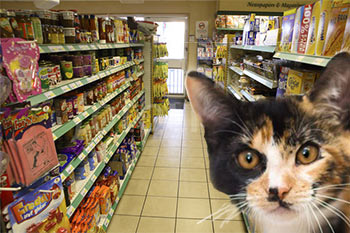 CRAIG LOOMIS
CRAIG LOOMIS
The Date
It’s nothing more than a yellow twinkle of car light but when it comes again, bigger and brighter, I put down the box I am carrying and step closer to the window to get a better look; and yes, it is their yellow VW. I scurry to the back room, grab the two-legged stool that is no good to anybody, and place it just right so the door stays ajar.
And of course, she is, like always, with her mother and they are both smiling like something is funny or about to be funny, and together the two of them take a shopping cart and make their way to aisle one: fruits and vegetables. Almost immediately they stop at the first bin and she holds up a cantaloupe and says something to her mother, and even from here I can see the mother saying no. She shrugs and gently replaces the cantaloupe. They continue because there are still tomatoes and cucumbers and potatoes to collect. Once they stroll pass the carrots—two bundles for 99 cents—the door is never ajar enough and when I give it a shove it creaks like something out of a haunted house. By the end of the aisle, where the milk and cheese begin, although I can hear their laughter, I lose track of them and quickly step to the other back room door as they move to aisle two.
At the second door I have to nudge the calico aside to get a better look. The cat does not like that and gives me a hey-what-are-you-doing hiss. By now they have added a carton of milk and two cans of beans to their cart. For some reason Denise and beans do not go together, and when I turn to frown at the cat, that has not stopped looking up at me, it hisses again. I have heard her girlfriends call her Denny, her brother calls her Den, and if Denny weren’t such a boy’s name I would like it too.
This is that part of the store where the floor is uneven with bad concrete, causing the shopping carts to rattle, their wheels to turn sideways. But never mind, and although the rattling sounds extra loud, the mother is in more of a hurry than she is, and when I see Denise looking around, as if she is looking for something, someone, of course all I can do is smile.
Aisle three is impossible to spy from the backroom, so I push open the door and work my way to aisle two: shelves of Campbell soup and a long row of brightly-colored cereals. I carefully rearrange the tomato soup cans to get a better view. Surprisingly, the mother has stopped to read the small print on a box of corn starch. I can only wonder what there is to read, what ingredients, what percentages or numbers she is looking for. As she reads, Denise shuffles her feet. There is something like a bruise on her elbow that I don’t remember seeing in math class. She is wearing the same blue dress she wore today, the one that ties in the back in a bow. Suddenly she turns my way, wide-eyed toward the tomato soup. I duck down like this is World War One and I am in a trench, frowning. In the meantime the calico has stepped out of the back room to watch me. I count slowly to ten—spending a little extra time between eight, nine and ten—before carefully taking a second look. And when I do—the mother’s reading all done and the corn starch back on the shelf where it belongs—they have moved on to the last aisle: breads, cooking oil and a long complicated shelf of assorted pickles. I have always thought this combination strange for any aisle and have told him so, more than once. But Dad, the expert grocer of ten, no, eleven years, only snickers when I bring it up, saying something like, “Everybody knows that bread and pickles go together. Everybody knows this.” As a rule, Denise and her mother never spend a lot of time in this last aisle, perhaps slowing the cart to pick up a loaf of wheat bread—33 cents.
Denise has short dark hair, not black but almost. She has a mouth that pouts; it doesn’t mean to but it does. But the best part of her face is that no-name place between nose and mouth—a tiny vanilla wiggle. The three times we have talked to one another, I have spoken directly to that place.
In the end, no thanks to her mother, they finish too quickly, push the cart to the counter, pay and laugh with Dad; and when he takes their money and hands them two bags of groceries, he says what he always says, “Thank you very much and come again… So good to see you.” As Denise and mother head out to their yellow VW, this is my signal to slowly make my way down aisle two, to the big window, cleverly slipping in behind the Coca Cola sign. I watch Denise place the bags in the back seat before she scoots to the front. Meanwhile the cat has followed me, and is now meowing, as if it wants to be fed, thinking nothing of giving away my hiding place. With fingertips on the window, and I step out from behind the Coca Cola sign. As the yellow VW gently backs away, Denise looks straight at me and waves. I wave back.
From the counter, Dad says, “What are you doing?” And when I don’t answer, he goes on, “Did you put those boxes away?”
To this I say OK, I will and with the calico trotting behind me, I head to the back room thinking: it doesn’t get much better than this.
© Craig Loomis, 2017
This story may not be archived, reproduced or distributed further without the author's express permission.
Please see our conditions of use.
The Barcelona Review is a registered non-profit organization
Author Bio
 For the last thirteen years Craig Loomis has been teaching English at the American University of Kuwait in Kuwait City. He has had his short fiction published in The Iowa Review, The Colorado Review, The Prague Revue, The Maryland Review, The Louisville Review, Bazaar, The Rambler, The Los Angeles Review, The Prairie Schooner and other literary journals. In 2013 Syracuse University Press published his short story collection The Salmiya Collection: Stories of the Life and Times of Modern Day Kuwait.
For the last thirteen years Craig Loomis has been teaching English at the American University of Kuwait in Kuwait City. He has had his short fiction published in The Iowa Review, The Colorado Review, The Prague Revue, The Maryland Review, The Louisville Review, Bazaar, The Rambler, The Los Angeles Review, The Prairie Schooner and other literary journals. In 2013 Syracuse University Press published his short story collection The Salmiya Collection: Stories of the Life and Times of Modern Day Kuwait.
